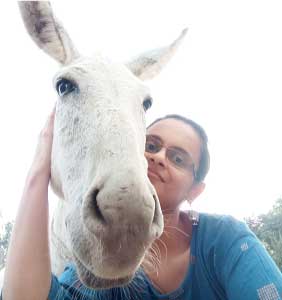What’s a winter weekend brunch without sizzling hot stuffed parathe, mixed vegetable pickle, and a bowl of thick and creamy vegan dahi? Curd is a necessity in winter, right? But as soon as the mercury dips, making curd becomes challenging—it just won’t set properly! Well, it’s not really the dahi’s fault. The good bacteria that convert the milk into curd require a warm and cosy environment to work their magic. Temperature plays a major role in the process of setting curd.
My hometown is one of the coldest cities in the plains of India yet my father manages to set the perfect curd even in the almost-freezing, dreary January weather. He’s not vegan but he’s the one who taught me the techniques of making the perfect vegan dahi 🙂
He uses animal milk, but I have successfully used his methods to make plant-based curds.
Here are the two techniques he employs:
1. Set Curd in an Insulated Casserole

Pour the warm vegan milk into an insulated casserole bowl and mix the starter curd. Close the lid and keep aside for 7-8 hours.
2. Wrap up the Bowl in a Warm Sweater/Shawl/Blanket

In case you’re not using an insulated casserole but a normal bowl for setting the curd, simply cover the bowl and wrap it up in a warm sweater or shawl. Leave to set for 7-8 hours.
Both of these techniques help to trap in the heat and maintain a temperature conducive for the bacteria to work in.
Additional tips:
1. At the time of adding the starter, the plant-based milk should be on the warmer side, though not hot.
2. More starter curd is needed in cold weather. Add about two tablespoons of starter curd per 500 ml of plant-based milk.
These methods work for all types of vegan curds; here are my favorite ones:
- Soy Curd with soy milk powder
- Homemade Soy Milk Curd
- Super-rich Soy-Cashew Curd
- Peanut-Rice Curd
- Creamy Peanut Curd
Note: This post only explains the techniques of setting vegan curd in winter; click on the above links for the descriptive recipes with full instructions.


 Namaste, I'm Namrata :)
Glad to see you here at my little blog Of Donkeys & Dhokla which is all about living a happy & fulfilling life as a middle-class vegan in India.
Here you will find easy recipes and useful DIYs made with ingredients that are affordable and readily available.
Namaste, I'm Namrata :)
Glad to see you here at my little blog Of Donkeys & Dhokla which is all about living a happy & fulfilling life as a middle-class vegan in India.
Here you will find easy recipes and useful DIYs made with ingredients that are affordable and readily available.
We make it in steel vessel and then keep the vessel in a cooker with lid tightly closed 🙂
Yes!! I also learned this technique a few months after publishing this post. Thank you for your comment, I’ll update the post with this method as well 🙂